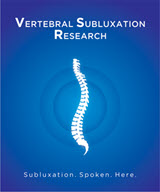The Senzon Papers – Exposing the Lies & Deception of the Subluxation Deniers

A new series of ten papers was recently published in the Journal of Chiropractic Humanities, all written by Simon Senzon, Ph.D. candidate at the School of Health and Human Sciences at Southern Cross University and recipient of the Foundation for Vertebral Subluxation's post-graduate scholarship.
Senzon, a prolific historical researcher on the chiropractic profession, has been awarded an Advancing Futures Scholarship by the Foundation for Vertebral Subluxation (FVS). The scholarship is for Dr. Senzon to complete a Ph.D at Southern Cross University located in Australia. The focus of his scholarship and dissertation will be correcting the errors in the literature regarding vertebral subluxation placed by numerous “subluxation deniers” who have peppered the scientific and historical literature with unreferenced and unsupported statements regarding the nature and historical issues surrounding vertebral subluxation.
The main plan for Senzon’s dissertation is to contribute to knowledge by exploring the professionalization of chiropractic by developing a new understanding of how intellectual fields develop. This will be conducted by using eight perspectives along with an in-depth literature review. The review will emphasize historical and scholastic errors in the literature as well as social science views of the profession. It is hoped that this unique contribution to knowledge will establish a new foundation for research into chiropractic, the chiropractic subluxation, health care, and professionalization.
In the articles, Senzon provides a critical overview of the development of theories of the Chiropractic Vertebral Subluxation from an historical perspective. Using primary source documents as the basis for the articles, Senzon develops a comprehensive insight into the ubiquity of subluxation theory and research throughout the chiropractic profession during its first 100 years.
Part 1 of the series is an introduction, which examines the controversies around the term “vertebral subluxation” within the profession.[1] He cites the various organizations seeking to dismiss the term as historical alongside those who embrace it as the foundation of the profession. Central to Senzon’s ten papers is the critique and analysis of Villanueva-Russell, who found that a small group of academics in the profession are staging a coup d’état by trying to “cleanse” the chiropractic lexicon.[2] The introduction to the series examines the flaws in some of those articles,[3-5] breaks down historical errors that arguments rest upon,[6-9] and lays out the rationale for establishing a shared base of knowledge for the entire profession. It is an evidence-based approach to historical writing.
Part 2 explores the subluxation theories developed between 1897 and 1907.[10] The main theorists from this period include D.D. Palmer and several of his early students such as B.J. Palmer, A.P. Davis, O.G. Smith, and S.M. Langworthy. The paper clarifies a timeline of the first usages of the term “sub-luxation” in the chiropractic literature. It also provides new distinctions about the theories of D.D. Palmer and develops the most comprehensive chronology to date on his theories of tone, impingement, intelligence, dis-ease, as well as sub-luxation. The paper also critiques literature that makes mistakes about this early history.[11, 12] Incorrect facts, often related to the ideas of the Palmers, are sometimes used to dismiss early chiropractic theory for various reasons.
Part 3 critiques the literature that makes erroneous claims that chiropractic has never had a clear identity.[13, 14] By examining the facts in the primary literature from the Palmers and other early school leaders like Loban, Howard, Carver, Firth, and Gregory, Senzon demonstrates that vertebral subluxation was the earliest identity for the profession in all books and teaching institutions. The vertebral subluxation theories developed between 1908 and 1915 became the foundation of future theory and practice. This period included D.D. Palmer’s final writings, five of B.J. Palmer’s first six books, as well as texts by the other school leaders. Research included clinical studies and the dissection studies of Smith, Forster, and Swanberg. The impact of Firth’s diagnostic approach is described for the first time in the literature as is the impact of Forster. Senzon revealed that Janse’s well-known book, The Principles and Practice of Chiropractic was actually an updated version of Forster’s 1915 text,[15, 16] without any attribution to Forster. Senzon highlights that the theories of D.D. Palmer, B.J. Palmer, and some of their contemporaries are often forgotten or ignored in the literature.
Part 4 examines the vertebral subluxation theories of Craven, Drain, Riley, and Stephenson.[17] Of the four, Stephenson is the most famous but there is very little written about his contribution to subluxation theories in the literature such as his vertemere cycle or his writings on cord pressures. Stephenson’s work was an extension of the work of his teacher, John Craven, who published two Green Books and helped B.J. Palmer to republish his three core philosophy texts.[18] Craven developed one of the first degenerative models of vertebral subluxation and also contributed to B.J. Palmer’s cord pressure model. Drain’s text, Chiropractic Thoughts,[19] published in 1927, should be viewed as the companion book to Stephenson’s text. It contains many of the same ideas written in plain language. Drain also added to the literature on cord pressure, chronic subluxation practice, and philosophy. Joe Riley was considered one of the greatest “mixers” of the era. However, Senzon noted, with inspiration from Stevan Walton,[20] that Riley integrated acupuncture theory with subluxation theory, which inspired many of the reflex techniques. Part 4 also describes the introduction of thermographic instrumentation into chiropractic objective findings and how the earliest studies influenced subluxation theory. Senzon observed that between 1916 and 1927, new subluxation perspectives emerged about; adaptation, cord pressure, excitation/inhibition, and chronicity versus acute vertebral subluxations. The complexity of thinking about chiropractic subluxation, philosophy, and an overall systems viewpoint were central for this period.[21] Finally, this paper addresses the issues of cognitive dissonance in chiropractic, which is sometimes levied against subluxation theorists. Senzon turns that on its head by noting that the true dissonance relates to confusing the chiropractic paradigm with the paradigm of biomedicine, and using an outdated and undifferentiated definition of innate intelligence in arguments against philosophy and subluxation.[22, 23] He also critiques the literature in relation to the chiropractic paradigm, which sometimes includes an overall lack of understanding about early theory, especially when that early theory is used as a rationale for dismissivism and subluxation denialism.[3]
Part 5 traces the increasing complexity of vertebral subluxation theory into the 1940s, with upper cervical models, reflex models, global models, and Speranskian models.[24] Important theorists include B.J. Palmer, R.J. Watkins, Galen Price, Joseph Janse, Jim Firth, and J.R. Verner. Technique developers include Hurley, Logan, DeJarnette, Van Rumpt, Ashton, and Gillet. To simplify the complexity that developed in vertebral subluxation models, Senzon describes eight new perspectives that emerged on; instrumentation, biomechanics, proprioception, neurodystrophic processes, the upper cervical spine, chronic patterns, and nontherapeutic perspectives, which were pioneered by B.J. Palmer and Gillet. This period was the first research era in chiropractic. Senzon highlights the critiques in the literature, especially the subluxation deniers, that take the ahistorical position that there has never been any research on vertebral subluxation.[4, 25-31] He demonstrates that position is false and discusses questions of validity and evidence-based medicine (EBM) in chiropractic research.
Part 6 examines the renaissance of chiropractic vertebral subluxation theory in the 1950s and 1960s and how D.D. Palmer’s theories were integrated back into the profession.[32] This paper includes theories from B.J. Palmer, T.F. Ratledge, Drain, Janse, Muller, Illi, and R.J. Watkins. Research during this period expanded to at least seven colleges and one institute. Vertebral subluxation research and theory focused on etiology, chronicity, biomechanics, neurology, stress, typologies, autonomic tone, reflex models, sympatheticatonia, Speranskian neurodystrophic theories, and “the higher reaches of health and well-being.” Few hypotheses from this era have yet to be researched with the myriad types of research strategies available today.
Part 7 examines techniques and models of vertebral subluxation developed between 1962 and 1980.[33] This includes influential texts from Weiant, Homewood, Harper, and Segmental Neuropathy.[34] Technique leaders discussed in this paper include Goodheart, Nimmo, Toftness, Ward, Gonstead, Grostic, Gregory, and Pierce. The evolution of vertebral subluxation theories and practices was significant during this period. Integration of diverse bodies of research were coupled with new vertebral subluxation research at National Chiropractic College, Canadian Memorial Chiropractic College, Texas Chiropractic College, and Los Angeles Chiropractic College. Seyle’s stress theories were embedded within subluxation theory for the first time. Instrumentation in chiropractic pushed the boundaries of research and theory to new levels of complexity. Three classes of instruments were utilized to detect vertebral subluxation by chiropractors; thermo-electric, bio-electric, and photo-electric. Senzon classified two new emergent perspectives on vertebral subluxation from this era; the stress perspective and the neuropathic perspective. Senzon also observed that even though B.J. Palmer had a significant impact on the theories of this era, few theorists cited his work. This period also included the first literature critiquing the term “subluxation” because it had its own medical definitions. These calls for change started after DeJarnette wrote that subluxation “has become the Rock of Gibraltar of this profession.”[35]
Part 8 explores terminology, the new historical consciousness in chiropractic, and the various consensus definitions that emerged about vertebral subluxation between 1966 and 1980.[36] This period included the Medicare acceptance of vertebral subluxation as the sole diagnosis for chiropractors, the formal acknowledgement of the CCE by the US department of education, the NIH conference on spinal and manipulative therapy, as well as consensus definitions from the chiropractic radiologists, and associations like the ACA. This period was a turning point for the profession in many ways as the focus of the profession shifted from care for all conditions and chiropractic as the last resort for medical failures to an emphasis on low back pain and headaches. One of the most important breakthroughs in chiropractic lexicon included the 1966 classification of five types of subluxation by the American College of Chiropractic Roentgenologists.[37] Maneuvers to shift the chiropractic lexicon away from adjusting vertebral subluxation and towards manipulative therapeutics were orchestrated in response to the new reliance on insurance and the need to get research funding. Several influential histories of chiropractic were published. Senzon notes that recent findings in various archives has led to the awareness that some historical writings from this period include factual mistakes.[38, 39] Senzon observed that new perspectives emerged from this body of literature including the neuropathic perspective, whereby an intervertebral subluxation may be viewed as a consequence of a neuropathy. This period also saw the emergence of the “objective straight chiropractic” movement. Senzon proposes that from this period forward all vertebral subluxation theories should be classified according to three categories; mechanically, neurologically, and organizationally.
Part 9 of the series explores how the development of the chiropractic vertebral subluxation theory and research grew so complex that international consensus statements and professional associations chose to describe it using terms like subluxation complex and subluxation syndrome.[40] Subluxation models were developed by Faye, Dishman, Lantz, Grostic, Barge, Gatterman, Gitelman, and Reinert. The ACA and ICA presented a shared definition to the WHO. A DELPHI process was undertaken by stakeholders from dozens of schools and organizations leading to agreed upon subluxation terminology greater than 80%. Theories during this period could be traced to D.D. Palmer’s viewpoint that subluxation leads to pathology, which he described as modified physiology, which we refer to today as pathophysiology. Some critical literature emerged during this period, to which Senzon points out there is a general lack of adequate evidence in their literature reviews to support various positions.[41, 42] During this period, R.J. Watkins noted a shift in the profession’s attitude towards subluxation including, to his amazement, some did not believe the profession had demonstrated efficacy, there was confusion as to why the neurophysiological component should be included, and there was a movement away from the terminology of subluxation and towards “manipulable lesion.” Senzon also points out several instances in the literature during this period, which contained factual errors about the history of subluxation theory.[41-44] Furthermore, he suggests that recent studies on inter-examiner reliability point to the need to reevaluate all literature from the past that relies on the findings of older studies.[41, 45-48] That argument is expanded on in Part 10.
Part 10 explores the apogee of subluxation discourse in the 20th century, the years 1996-1997.[49] During this two-year period the chiropractic discourse included Rome’s overview of 296 subluxation synonyms, Bergmann’s PARTS diagnostic protocol, Ruch’s Atlas of Common Subluxations, the first volume of Boone’s Journal of Vertebral Subluxation Research (JVSR), and two well-cited critiques of subluxation research and discourse published in peer-reviewed journals. Senzon includes an examination of some of the misinformation in the literature about JVSR and sets the record straight, that it has always been an indexed peer-reviewed scholarly journal. The article also explores the legacy of Epstein’s subluxation models, an overview of Kent’s classic models of subluxation, as well as a summation of JVSR’s first volume with an appraisal of Boone and Dobson’s Vertebral Subluxation Model including their call for a functional definition of vertebral subluxation. Part 10 also includes the first comprehensive overview of Joe Keating’s writings on vertebral subluxation, with an emphasis on his well cited article, To Hunt the Subluxation.[46] Keating and Nelson are cited as two excellent examples of subluxation critiques that lack solid evidence, and include factual mistakes, and yet, even though both are cited in the literature to further subluxation denialism, there is very little criticism of the papers, until now.[46, 50] Senzon noted that a consensus between Keating, Kent, Boone, and Dobson was the need for definitions of vertebral subluxation that could be used to in research from multiple perspectives.
Senzon’s ten part series on the Chiropractic Vertebral Subluxation is a turning point for the chiropractic literature. Evidence of the ubiquity of the chiropractic vertebral subluxation throughout the entire profession for 100 years, is proof that there should be no justification for any future papers in the peer-reviewed literature to suggest things like; subluxation is only an historical phenomenon, that subluxation was only developed to support legal arguments, that there is only one type of subluxation theory that dates to the turn of the last century, that vertebral subluxation was only an aspect of one faction of the profession, or that there is no research to support the myriad vertebral subluxation theories. The evidence clearly suggests that the chiropractic vertebral subluxation was the central identity of the chiropractic profession for its first one-hundred years, that the research and theory grew to such a significant body of literature by the 1970s the US government recognized the importance of studying it further and by the 1990s there was profession-wide consensus on vertebral subluxation. Chiropractic vertebral subluxation theory has grown in complexity, in theory, practice, and research, since 1897. There are still many hypotheses about the chiropractic vertebral subluxation to be studied using mixed methods research protocols.

References
- Senzon, S., The chiropractic vertebral subluxation part 1: The Need for a Complete Historical Record. J Chiropr Hum, 2018. 25: p. 10-21.
- Villanueva-Russell, Y., Caught in the crosshairs: Identity and cultural authority within chiropractic. Social Science & Medicine, 2011. 72(11): p. 1826-1837.
- Keating, J., et al., Subluxation: dogma or science. Chiropractic & Osteopathy, 2005. 13(17): p. 1-10.
- Murphy, D., et al., How can chiropractic become a respected mainstream profession? The example of podiatry. Chiropractic & Osteopathy, 2008. 16(10).
- Mirtz, T.A., et al., An epidemiological examination of the subluxation construct using Hill's criteria of causation. Chiropr Osteopat, 2009. 17: p. 13.
- McGregor, M., et al., Differentiating intraprofessional attitudes toward paradigms in health care delivery among chiropractic factions: results from a randomly sampled survey. BMC complementary and alternative medicine, 2014. 14(1): p. 51.
- Wardwell, W., Chiropractic: History and evolution of a new profession. 1992, St. Louis(MO): Mosby.
- Lerner, C., The Lerner report. 1952, Davenport, IA.: Palmer College Archives.
- Rehm, W., Legally defensible: Chiropractic in the courtroom and after, 1907. Chiropr Hist, 1986. 6: p. 51-55.
- Senzon, S., The chiropractic vertebral subluxation part 2: The Earliest Subluxation Theories from 1897-1907. J Chiropr Hum, 2018. 25: p. 22-35.
- Nelson, C., et al., Chiropractic as spine care: a model for the profession. Chiropractic & Manual Therapies, 2005. 13(1): p. 9.
- Moore, S., Chiropractic in America: The history of a medical alternative. 1993: Johns Hopkins University Press.
- Schneider, M., et al., 21st century paradigm for chiropractic. Journal of the American Chiropractic Association, 2005. Jan/Feb: p. 8-15.
- Senzon, S., The chiropractic vertebral subluxation part 3: Complexity and Identity from 1908 to 1915. J Chiropr Hum, 2018. 25: p. 36-51.
- Janse, J., R.H. Houser, and B.F. Wells, Chiropractic principles and technic: For use by students and practitioners. Second ed. 1978, Chicago: National College of Chiropractic.
- Forster, A., Principles and practice of spinal adjustment. 1915, Chicago, IL: National School of Chiropractic.
- Senzon, S., The chiropractic vertebral subluxation part 4: New Perspectives and Theorists from 1916-1927. J Chiropr Hum, 2018. 25: p. 52-66.
- Faulkner, T., J. Foley, and S. Senzon, Palmer chiropractic green books: The definitive guide. 2018, Asheville, NC: The Institute Chiropractic.
- Drain, J.R., Chiropractic thoughts: Second edition. 1946.
- Walton, S., Evolution of Reflex Techniques. unpublished.
- Senzon, S., Chiropractic and systems science. Chiropractic Dialogues, 2015. December 25: p. 9-20.
- Gliedt, J., et al., Chiropractic identity, role and future: a survey of North American chiropractic students. Chiropractic & manual therapies, 2015. 23(1): p. 1.
- Senzon, S., Causation related to self-organization and health related quality of life expression based on the vertebral subluxation model, the philosophy of chiropractic, and the new biology. J Vertebral Subluxation Res, 1999. 3(3): p. 104-112.
- Senzon, S., The chiropractic vertebral subluxation part 5: The First Research Era from 1928-1949. J Chiropr Hum, 2018. 25: p. 67-85.
- Seaman, D., Philosophy and science versus dogmatism in the practice of chiropractic. J Chiropr Humanit, 1998. 8: p. 55-66.
- Mirtz, T., Universal intelligence. J Chiropr Humanit, 1999. 9: p. 55-71.
- Huijbregts, P., The chiropractic subluxation: implications for manual medicine. J Man and Phys Ther, 2005. 13(3): p. 139-141.
- Bronfort, G., et al., Effectiveness of manual therapies: the UK evidence report. Chiropractic & osteopathy, 2010. 18(1): p. 1.
- Reggars, J., Chiropractic at the crossroads or are we just going around in circles? Chiropractic & manual therapies, 2011. 19(1): p. 1.
- Carter, R., Subluxation-the silent killer. J Can Chiropr Assoc, 2000. 44(1): p. 9.
- Keating, J., et al., In the quest for cultural authority. Dyn Chiro, 2004. 26(22): p. 1-2.
- Senzon, S., The chiropractic vertebral subluxation part 6: Renaissance of D.D. Palmer's Paradigm from 1949-1961. J Chiropr Hum, 2018. 25.
- Senzon, S., The chiropractic vertebral subluxation part 7: Technics and Models from 1962-1980. J Chiropr Hum, 2018. 25: p. 99-113.
- Petersen, A.R., R.J. Watkins, and M. Himes, Segmental neuropathy: the first evidence of developing pathology. Online ed. 2014, https://www.institutechiro.com/waves/1928-1975/sixth-wave-chiropractic/s... Canadian Memorial Chiropractic College/The Institute Chiropractic.
- DeJarnette, M.B., The chiropractic subluxation. The ACA Journal of Chiropractic, 1965. 2(6): p. 8-11.
- Senzon, S., The chiropractic vertebral subluxation part 8: Terminology, Definitions, and Historicity from 1966-1980. J Chiropr Hum, 2018. 25: p. 114-129.
- Walton, S., The complete chiropractor: RJ Watkins, DC, PhC, FICC, DACBR. 2017, Asheville, NC: The Institute Chiropractic.
- Janse, J., History of the development of chiropractic concepts: Chiropractic terminology, in The research status of spinal manipulative therapy: A workshop held at the National Institutes of Health, February 2-4, 1975, M. Goldstein, Editor. 1975, U.S. Department of Health, Education, and Welfare: Bethesda. p. 25-42.
- Haldeman, S. and K. Hammerich, The evolution of neurology and the concept of chiropractic. ACA Journal of Chiropractic, 1973. VII(S-57): p. 60.
- Senzon, S., The chiropractic vertebral subluxation part 9: Complexes, models, and consensus from 1981-1995. J Chiropr Hum, 2018. 25: p. 130-145.
- Charlton, K., Approaches to the demonstration of vertebral subluxation: 1. introduction and manual diagnosis: a review. J Australian Chiropr Assoc, 1988. 18(1): p. 9-13.
- Brantingham, J., A critical look at the subluxation hypothesis. J Man Phys Ther, 1988. 11(2): p. 130-132.
- Leach, R., The chiropractic theories: A synopsis of scientific reaserch. 1980, Missisiippi State, MS: Mid-South Scientific Publishers.
- Lantz, C., The vertebral subluxation complex: Part 1. Chiropractic Research Journal, 1989. 1(3): p. 23-36.
- Keating, J., Science and politics and the subluxation. Amer J Chiropr Med, 1988. 1(3): p. 107-10.
- Keating, J., To hunt the subluxation: clinical research considerations. J Man and Phys Ther, 1996. 19(9): p. 613-619.
- Cooperstein, R., M. Young, and M. Haneline, Interexaminer reliability of cervical motion palpation using continuous measures and rater confidence levels. J Can Chiropr Assoc, 2013. 57(2): p. 156-164.
- Holt, K., et al., Inter-examiner reliability of the detection of vertebral subluxations using continuous measures and confidence levels. J Chirpr Educ, 2016. 30: p. 59.
- Senzon, S., The chiropractic vertebral subluxation part 10: Integrative and Critical Literature from 1983 to 1997. J Chiropr Hum, 2018. 25: p. 146-168.
- Nelson, C., The subluxation question. J Chiropr Hum, 1997. 7: p. 46-55.

Blogs
- The Chiropractic Cartel: A Look Back at Bias in Accreditation and its Imact on Today's Profession
- Inside Montana's Chiropractic Monopoly: ACA & MCA's Brazen Board Takeover
- Concerns Grow About Control of the NY State Chiropractic Board by the ACA - Use of X-ray in NY Under Threat
- Reproductive Health Information and Chiropractic Care: Navigating New Privacy Regulations
- Navigating Substance Use Disorder (SUD) Consent: What Chiropractors Need to Know













